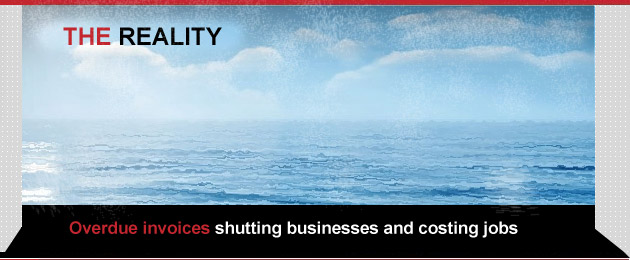Business Debts...
The Insolvency Act 1986 | Who May Be Liable? | What Is Expected Of Directors?
The Amount Of The Award | Barriers To Wrongful Trading Actions | Text Of Section 214
Directors and the Consequences of Wrongful Trading
Wrongful trading is a type of civil wrong found in UK insolvency law, under s 214 Insolvency Act 1986. It was introduced to enable contributions to be obtained for the benefit of creditors from those responsible for mismanagement of the insolvent company.
The Insolvency Act 1986
The principle of wrongful trading was introduced in the Insolvency Act 1986, to complement the concept of fraudulent trading. Unlike fraudulent trading, wrongful trading needs no finding of 'intent to defraud' (which requires a heavy burden of proof). Wrongful trading is therefore a less serious, and more common offence than fraudulent trading.
Under UK insolvency law, wrongful trading occurs when the directors of a company have continued to trade a company past the point when they:
"knew, or ought to have concluded that there was no reasonable prospect of avoiding insolvent liquidation"; and
-
they did not take "every step with a view to minimising the potential loss to the company’s creditors".
Wrongful trading is an action that can be taken only by a company's liquidator, once it has gone into insolvent liquidation. (This may be either a voluntary liquidation - known as Creditors Voluntary Liquidation, or compulsory liquidation). It is not available to the directors of a company while it continues in existence, or to other insolvency office-holders such as an administrator.
Where, during the course of a winding-up, it appears to the liquidator that wrongful trading has occurred, the liquidator may apply to the Court for an order that any persons who were knowingly parties to the carrying on of such business are to be made liable to make such contributions to the company's assets as the court thinks proper.
Who may be liable?
Section 214 Insolvency Act 1986 has very wide scope, since it applies not only to de jure directors (that is directors who were formally appointed and their appointment was registered with Companies House. It can apply to de facto directors (that is people who assumed the role of director of a company without being appointed), or shadow directors (that is people in accordance with whose direction the de jure directors were accustomed to act.
Initially, there was uncertainty among banks and insolvency and restructuring professionals who assisted and advised companies facing insolvency that they may be caught by the wrongful trading provisions. This has not proved to be the case (as of July 2006), and professionals are unlikely to be covered by these provisions except in exceptional circumstances.
What is expected of directors?
In order to establish liability, the liquidator needs to demonstrate, using the civil burden of proof (i.e. on the balance of probabilities) that the directors continued trading the company beyond a point in time when they knew, or ought to have ascertained, that insolvent liquidation was inevitable.
The facts a director ought to have known were those a reasonably diligent person—having both the skill and experience possessed by a reasonable director—together with the skill and experience actually possessed by that individual. This means that there is a two-fold test for knowledge. There is a general level of skill required for all directors under the first part of the test. Under the second, a higher standard of knowledge is required by those with specialist skills. (These are likely to be accounting or legal skills). This principle has been confirmed in a 1999 case where an executive husband had to pay £210,000 to the liquidator compared with his non-executive wife's £50,000.
The normal approach to wrongful trading actions is that the liquidator will try to establish a date at which the company can be shown to be balance sheet insolvent, and then show why it was unreasonable for directors to continue to trade after this. In the UK, and contrary to many misconceptions, it is not an offence to trade a company while it is insolvent. Indeed in some situations, if the directors genuinely believe that the position will be turned around and the position of creditors will improve, it is the correct thing to do. When it becomes wrongful trading is when it should have been realised that the position of the creditors would likely deteriorate from that position onwards and the company would proceed into liquidation. Once a director realises that his or her company is insolvent, one important thing for them to do is to seek immediate professional advice from a licensed insolvency practitioner.
Many legal systems (including English law) recognise the blue skydefence; which broadly provides that, if the directors, in good faith, believed the company was about to turn the corner and improve, they would not normally be held liable for continuing to trade. Liability only attaches when the company has no realistic prospect of avoiding insolvent liquidation.
The amount of the award
The Court has wide discretion over the contribution that it can require. Traditionally this has been compensatory, rather than punitive. The starting point for assessing the appropriate amount was the difference between the net assets of the company at the date that the directors should not have traded beyond, and the net assets at the date of liquidation.
The Court however has wide discretion, and may award just a percentage of this. It awarded 70% of the drop in net assets in Re Brian D Pierson (Contractors) Ltd [1999] BCC 903. This was on the basis of the judge’s "guesstimate" that 70% of the drop in net assets was due to the actions of the directors, and 30% could be attributed to extraneous causes.
Barriers to wrongful trading actions
It was thought prior to 1997 that the amount paid by a director following a wrongful trading claim was simply paid to the liquidator and it became available to swell the assets of the company generally. In most instances there would have been substantial bank borrowings secured by a debenture and personal guarantees given by the directors. Many directors chose not to fight the claims, reasoning that any amounts paid to company (hence the bank under its mortgage security) via a wrongful trading claim, simply reduced the director’s liability under their personal guarantees. It was therefore irrelevant how the directors repaid the bank. This changed with the Court of Appeal’s decision in 1998 that a claim for wrongful (or fraudulent) trading, is different from a normal 'asset' of the company. In particular, it held that such claim cannot be secured by a debenture. The Court held that the fruits of a claim for wrongful trading are instead held in trust by the liquidation for the general body of unsecured creditors. It then followed that the costs of a wrongful trading action could not be drawn from the company’s assets held by the liquidator, and fell to be paid personally either by the liquidator (which he would not do), or would require a unanimous decision of unsecured creditors. The position has now been clarified with the Enterprise Act 2002 changing the law to allow the costs of wrongful trading actions to be included as a cost of the liquidation. These can be met from the company’s assets.
As is often the case, a company in liquidation has no assets with which to bring an action for wrongful trading. How can the liquidator bring, or fund an action? Can the liquidator sell or assign the claim to a specialist litigation company?
Because a claim for wrongful trading is a personal action brought by the liquidator, it follows that if it is unsuccessful, the liquidator is personally liable for the legal costs of the defendants. This was found to be the case following a 5 months trial in which the liquidator of Continental Assurance Company of London plc sued a number of its directors. Although the costs of an action (whether successful or otherwise) can now be properly paid by the liquidator out of company assets where there are adequate funds available, the House of Lords in 2004 altered the hitherto accepted priority of costs in a liquidation, making the liquidator's costs (including the legal costs of a wrongful trading action) rank last in priority behind both preferential creditors and the sums due to debenture holders. The decisions in Continental Assurance and Leyland Daf make wrongful trading actions unattractive to liquidators.
It is now usual practice for liquidators to enter into conditional fee arrangements with lawyers and have insurance against adverse costs in place in the event that he is unsuccessful. The liquidator is able to assign the action regardless of the normal rules relating to champerty and maintenance. (He is empowered by statute to sell any of the company’s property). As an alternative, there are commercial litigation funding organisations that take over management and funding of the entire claim, and pay the liquidators a percentage of recoveries.
Text of section 214
The wrongful trading provision in s 214 IA 1986 is as follows.
214. Wrongful trading.
(1) Subject to subsection (3) below, if in the course of the winding up of a company it appears that subsection (2) of this section applies in relation to a person who is or has been a director of the company, the court, on the application of the liquidator, may declare that that person is to be liable to make such contribution (if any) to the company’s assets as the court thinks proper.
(2) This subsection applies in relation to a person if—
(a) the company has gone into insolvent liquidation,
(b) at some time before the commencement of the winding up of the company, that person knew or ought to have concluded that there was no reasonable prospect that the company would avoid going into insolvent liquidation, and
(c) that person was a director of the company at that time...
(3) The court shall not make a declaration under this section with respect to any person if it is satisfied that after the condition specified in subsection (2)(b) was first satisfied in relation to him that person took every step with a view to minimising the potential loss to the company’s creditors as (assuming him to have known that there was no reasonable prospect that the company would avoid going into solvent liquidation) he ought to have taken.
(4) For the purposes of subsections (2) and (3), the facts a director of a company ought to know or ascertain, the conclusions he ought to reach, and the steps he ought to take are those that would be known or ascertained, or reached or taken, by a reasonably diligent person having both—
(a) the general knowledge, skill and experience that may reasonably be expected of a person carrying out the same functions as are carried out by that director in relation to the company, and
(b) the general knowledge, skill and experience that that director has.
(5) The reference in subsection (4) to the functions carried out in relation to a company by a director of the company includes any functions he does not carry out but that have been entrusted to him.
(6) For the purposes of this section a company goes into insolvent liquidation if it goes into liquidation at a time when its assets are insufficient for the payment of its debts and other liabilities and the expenses of the winding up.
(7) In this section “director” includes a shadow director.
(8) This section is without prejudice to section 213.







